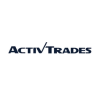Check our ranking of the best trading applications with API, ideal for traders who enhance their strategies with their own code. These applications stand out for their advanced algorithms, user-friendly interfaces, and automated trading capabilities.
BEST ETF TRADING PLATFORMS
Explore our ranking of the best platforms for ETF trading, essential for traders seeking diversified investment options. These brokers stand out for their wide range of ETFs, competitive terms, and valuable investment resources.

Ranking Methodology
In our quest to compile the ranking of the best ETF trading platforms, we have employed a detailed and comprehensive methodology to ensure that our recommendations are credible and align with the specific needs of ETF traders.
Our evaluation process is based on several key factors, each essential to identifying the platforms that stand out in ETF trading.
Variety and Diversity of ETF Offerings: A critical aspect is the variety and breadth of ETFs available on the platform. We evaluated the range of ETFs on each platform, including international, sector-specific, and thematic ETFs. Platforms that offer a broader and more diverse range of ETFs scored higher in our ranking.
User Experience and Interface: The usability of the platform plays a significant role in ETF trading. We assessed the ease of navigating the platform, executing trades, and accessing key information. Platforms with user-friendly interfaces and robust trading tools were favoured.
Research and Information Tools: Access to quality research and analysis is essential for informed ETF trading. We examined the depth and usefulness of research tools, market insights, and educational resources on each platform.
Cost Efficiency and Pricing Transparency: While focusing on ETF trading, we considered each platform's cost structure, including any commissions, expense ratios, and other associated costs. Platforms that offer competitive pricing and transparent fee structures were preferred, especially those providing commission-free ETF trades.
Selection of ETFs and Diversification Options
Exchange-traded funds (ETFs) have become a cornerstone in many investors' portfolios due to their versatility, profitability, and diversification benefits.
Understanding the breadth of the ETF selection and how they contribute to portfolio diversification is essential for making informed trading and investment decisions. Below, we present some of the most traded:
S&P 500 ETFs (e.g., SPDR S&P 500 ETF Trust - SPY): These ETFs track the S&P 500 index, offering broad exposure to large-cap U.S. stocks. The investment strategy here focuses on replicating the S&P 500 performance, suitable for investors seeking exposure to the U.S. equity market.
Total Market ETFs (e.g., Vanguard Total Stock Market ETF - VTI): They expose the entire U.S. equity market, including small, medium, and large-cap stocks. The strategy is to provide diversified exposure across all market capitalizations.
Nasdaq-100 ETFs (e.g., Invesco QQQ Trust): Focused on the Nasdaq-100 index, these ETFs carry significant technological weight and include some of the largest companies in the tech sector. The investment strategy targets growth through exposure to leading tech stocks.
Sector ETFs (e.g., Financial Select Sector SPDR Fund - XLF): These ETFs offer exposure to specific economic sectors like technology, health, or finance. Investors use them to gain exposure to specific industry trends.
International ETFs (e.g., Vanguard FTSE Developed Markets ETF - VEA): They provide exposure to markets outside the U.S. They're used for geographic diversification and to capitalize on the growth potential of international markets.
Emerging Market ETFs (e.g., iShares MSCI Emerging Markets ETF - EEM): These ETFs invest in stocks from emerging market countries. The strategy is to benefit from the growth potential in these rapidly developing economies.
Bond ETFs (e.g., iShares Core U.S. Aggregate Bond ETF - AGG): They offer exposure to various types of bonds, including government, corporate, and municipal bonds. The strategy typically aims to provide stable income and reduce portfolio volatility.
Commodity ETFs (e.g., SPDR Gold Shares - GLD): These ETFs provide exposure to commodities such as gold, oil, or agricultural products. They are often used as a hedge against inflation or market volatility.
ETFs offer direct access to market prices, ensuring competitive and fair trading conditions. Their transparent nature and the absence of spreads make them an ideal choice for traders focused on low or zero-cost trading solutions. The suitability of ECN accounts for high-volume traders enhances their effectiveness in a zero-commission model.
YOU MAY ALSO BE INTERESTED







